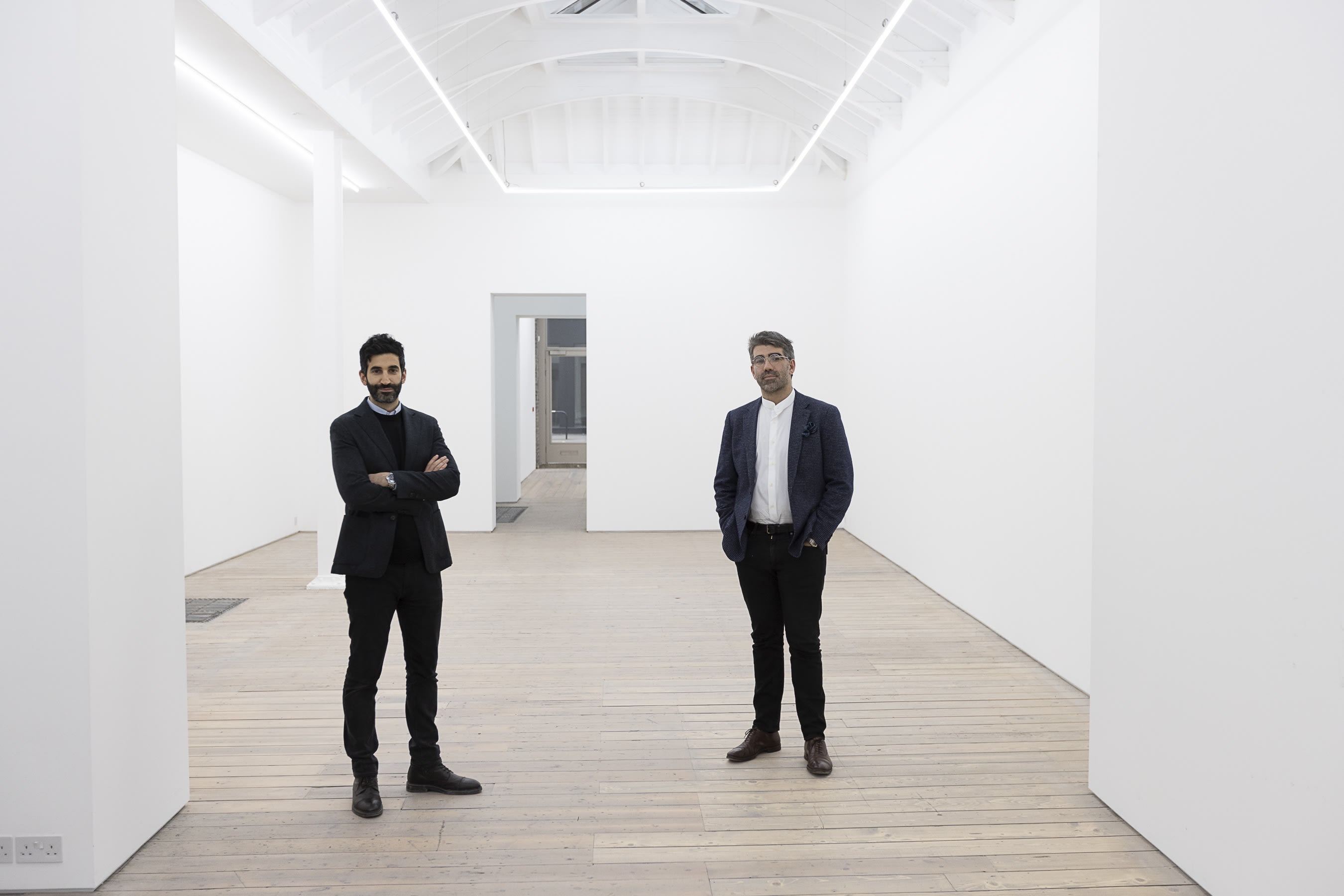31 January 2022 Co-founders Jeremy Epstein and Charlie Fellowes want to nurture their artists even as mega-galleries lurk.
Not many art galleries start in secret. But when Jeremy Epstein and Charlie Fellowes launched Edel Assanti in 2010, it was in the wake of the financial crisis and — without significant private backing — they needed to keep their day jobs, Fellowes at Hamiltons photography gallery, Epstein at Gagosian. “We were financially very hand-to-mouth,” says Epstein. That explains the gallery name, seemingly unrelated to the pair, though in fact “Edel” is Epstein’s grandmother’s maiden name and “Assanti” is the surname of a sculptor who eloped with Fellowes’s great-grandmother.
At the end of January, Epstein and Fellowes marked their 11-year trajectory with the opening of a striking new space on Little Titchfield Street in Fitzrovia, designed by hip London architects Sanchez Benton. The light-filled gallery has three exhibition rooms across two floors, plus ample office and storage space. “The heritage planning officer here was the same one as when we started out,” says Fellowes. “He was pleasantly surprised to see that the gallery had gone from being a pop-up space in a derelict office building in Victoria to where we are today.”

Jeremy Epstein and Charlie Fellowes. Photo: Will Amlot.
The no-nonsense pair met through a contact who thought they would have common ground. “We went for a beer,” Epstein says. “It was a Sliding Doors moment,” Fellowes adds. Each of the thirtysomethings sports a hipster look, with glasses and beards of varying thickness. But they aren’t so much trendy upstarts as art historians whose light-hearted camaraderie belies their attention to detail. When we initially chat over Zoom, they don’t so much interrupt each other as overlap — it seems a very natural working relationship.
Once they had taken the plunge and left their day jobs, their more careful characteristics set the tone. “Everything has always been very considered. It’s been a case of taking measured risks rather than a leap of faith,” Fellowes says.
All the while, they were building their stable of artists, nurturing the talent of people generally around the same age as them and growing together. It’s an old-fashioned way to do business, often referred to with rose-tinted nostalgia as the “Castelli model”, in deference to the postwar New York gallerist Leo Castelli, who became successful alongside such artists as Andy Warhol and Roy Lichtenstein. Others have since succeeded in a similar vein — in London this includes gallerists such as Maureen Paley and Sadie Coles — but it is a harder road to stick to in today’s relentlessly international, open-all-hours art market.
Fellowes and Epstein are the first to acknowledge that things are not quite the same in the 2020s. Epstein characterises the shift: “Even back in 2010, it really was a word-of-mouth industry. We knew who we had to get in front of the works and tried to get them there. Now — well, we had an online group show during lockdown and created a lot of content.
“We had visitors from Asia, the US — all collectors who were very forward in introducing themselves to us [virtually]. It opened our eyes. Anyone starting out now really needs to understand their digital footprint. Things are completely different.”
They recognise the risks. Just as major football clubs poach up-and-coming players from lower-league teams, the increased visibility of Edel Assanti’s artists makes the gallery more vulnerable to some of the harsher realities of the art market. “We can’t compete with the larger galleries in terms of scale. But we can compete in terms of quality and character, we have a depth of engagement that is quite hard to match,” Epstein says.
Their grown-up, elegant gallery is marking its next stage with an opening show of French artist Noémie Goudal, who summarises the conceptual and research-led approach of many of the artists they represent. Goudal’s work takes time to understand. The press release for Post Atlantica includes the word “palaeoclimatology” — a first for me — but the show is no less eye-catching for its exploration of deep time.
A four-metre aluminium installation spliced with photographic prints of palm trees weighs heavy in the central gallery. Nearby, a three-part film projection has waves crashing on the French coastline while, in the more intimate downstairs space, a lush film (more palm trees and water) confounds us with metallic, mechanical sounds. A cooler room, with photographs of snow-capped mountains and self-contained porcelain sculptures, disarms visitors at the back of the gallery.
Goudal was one of the first artists to sign up to the gallery, having shown in their initial group exhibition in Victoria. “We didn’t sell any of her work from that show; she was a slow-burn, but became a commercial linchpin,” Epstein says. By 2014, they were behind Goudal’s first solo show in a public museum, the New Art Gallery Walsall, an institution that Fellowes notes has been supportive of their other artists too.
Epstein’s other role is as the co-founder of London Gallery Weekend, a successful collaborative event launched last year to galvanise momentum through the city’s many independent spaces. This spirit continues into the Fitzrovia gallery, where Fellowes and Epstein will offer space to an overseas gallery when possible. First up later this year is New York’s Franklin Parrasch, whom Epstein describes as “an inspirational gallerist, something of a mentor”.
They are excited about the next chapter, which includes the recent hire of a new director, the writer and broadcaster Cleo Roberts-Komireddi. Fellowes says, “Our greatest satisfaction and pleasure comes from seeing people in the gallery on a Saturday who might not otherwise have been there. We get a real kick from that.”
